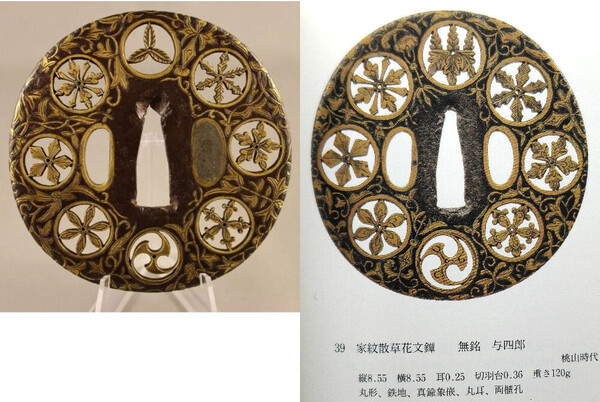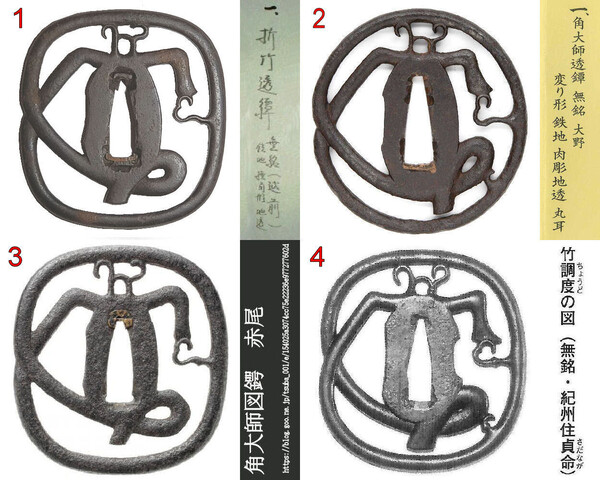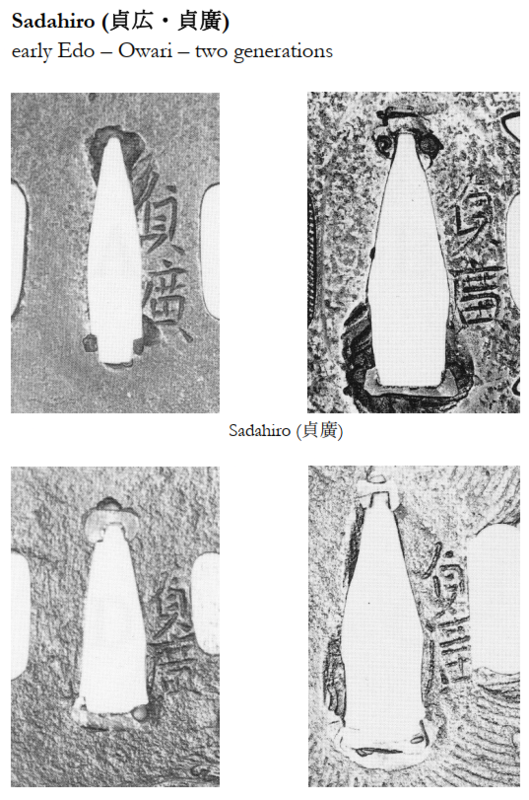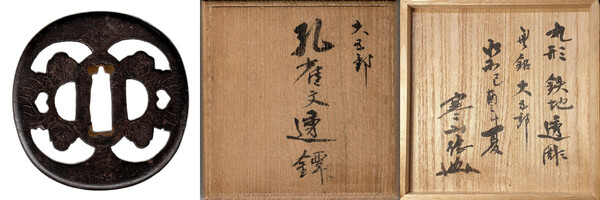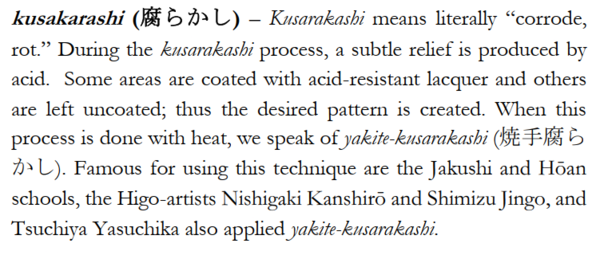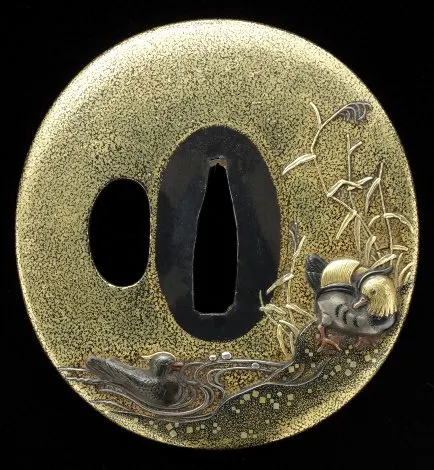-
Posts
798 -
Joined
-
Last visited
-
Days Won
4
Content Type
Profiles
Forums
Events
Store
Downloads
Gallery
Everything posted by MauroP
-
Who knows?...
-
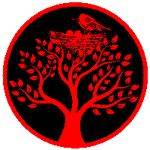
translation Help Understanding NBTHK Attribution Kanemichi
MauroP replied to MikeyJ's topic in Translation Assistance
Hi, your translation is correct. No idea about its meaning. -
All right folks, first of all I want to assure that no intended disrespect to NBTHK shinsa activity from me. Simply I feel sometime confortable in expressing a different opinion. Here below another tsuba attributed to Heianjō-zōgan, showing a quite typical decoration with ranma-sukashi usually associated with Yoshirō-zōgan tsuba. I fully agree with Luca when he says that the tsuba we are dealing about is a "manual piece". Indeed here below the tsuba submitted by Justin paired with a very close example described as Yoshirō, taken from "Tanoshi Shinchū Zōgan Tsuba: 100 Tsuba" by Ōtani Sadao.
-
Luca, stai parlando male di Garibaldi! (it's an Italian idiomatic expression to say that some opinions cannot be challenged even if overtly misleading)
-
No. 1 – My recently acquired tsuba with an old tokubetsu kichō paper; attribution to Echizen school and described as folded bamboo (oritake sukashi tsuba - 折竹透鐔). No. 2 – Described as Tsuno Daishi sukashi tsuba (角大師透鐔), attribution to Ōno school. No. 3 – Tsuno Daishi no zu tsuba, attributed to Akao school from a well known Japanese blog (https://blog.goo.ne....c75e22236e977277602d). No. 4 – Subject described as bamboo object (take chōdo - 竹調度) and very precisely attributed (albeit mumei) to Kishū jū Sadanaga in “Tsuba: Ishō to Waza no Bi” by Hayashi Eiroku, p. 88. Already mentioned here above is another similar tsuba reported in “The Birmingham Museum & Art Gallery Tsuba collection” by Grev Cooke, p. 94, attribution to Shōami school. So what’s really depicted in these tsuba? Maybe a bamboo talisman representing Tsuno Daishi? Still looking for answers on the subject (no hope to know which school produced the tsuba...)
-
Thanks Pier, here the updated version of the document (I messed up even in the Latin title): https://www.dropbox....pdf?st=d2taebmh&dl=0
-
A traditional representation of suzume - 雀 - sparrows, that could well be (ko)-Shōami or Owari (less likely due to the nunome-zōgan).
-
Hi Mike, nice catch as first tsuba. Curran prompted me to give my not-so-educated contribution. So here we have a piece we may describe as: mitsu tsuru no zu tsuba - 三つ鶴図鐔 maru-gata tetsu-ji nikubori ji-sukashi kin-tsuyu-zōgan - 丸形 鉄地 肉彫地透 金露象嵌 ryō-hitsu-shitate (kata-ategane) - 両櫃仕立 (片当金). I assume this is a wakizashi-sized tsuba from the middle/late Edo period, not easy to assign to a defined school/tradition. I would suggest 3 hypotheses: Echizen (越前), Bushū (武州) or Shōami (正阿弥). Here just one example for each call:
-
勾玉・曲玉 - magatama, literally curved jewel. Like hōju, magatama has also a religious significance, but it pre-dates (for many centuries) the Buddhist tradition. A magatama is one of the three imperial regalia of Japan (with a mirror and a sword).
-
A classical ko-kinkō tsuba, the waves design clearly would lose coherence if mounted on a edge-down blade. The signature looks quite amatourish in its quality, so mayby someone has carved it as a personal (and wrong) attribution. Just my hypotesis.
-
There is a counterexample for everything (in tōsōgu speculation, at least...), that's why basically I'm no more interested in attribution to school, provided one consider it no more than a fun game (like recognize incense flavours).
-

Nobunaga + Nagamasa, Help Please
MauroP replied to Bruce Pennington's topic in Translation Assistance
Actually the paper reports 無銘 (越前関) - mumei (Echizen Seki) -
Thank you Moriyama-san. So I suppose that hakogaki was not intended for my tsuba (and the attribution to Daigorō-ha should have made me doubt from the beginning).
-
My latest acquisition is a tsuba with hakogaki by Satō Kanzan. Despite my effort I'm unable to sort out one of the kanji describing the tsuba, so I'm unsure about a matching between the tsuba and its kiribaki. The date of the appraisal is also unclear to me. Here below my partial transcription: 大五郎 - Daigorō 孔▢文透鐔 - ???-mon sukashi tsuba 丸形鉄地透彫 - maru-gata tetsu-ji sukashibori 無銘 大五郎- mumei Daigorō 昭和▢▢年夏- Shōwa ??? 寒山誌 - Kanzan shirusu (+kaō) Thanks all.
-
-
Actually the hozon paper correctly report Kyō-kanagushi, wich is different from Kyō-kinkō (and surely nothing to do with ko-kinkō).
-
The transcription is 哥德呀, but no idea how to read it.
-
-
The higher the percentage of zinc in brass, the harder the alloy (and so less apt for sekigane). I suppose that brass with low-content in zinc could be good for sekigane, but all iron tsuba I have in my collection have dark reddish sekigane, so more probably made of copper/yamagane. But I'm not a metallurgist...
-
Well, Thomas, actually I see a problem if at the best of knowledge the top experts give inconsistent or variable attributions. The point is simply nobody knows for sure, the attributions are no more than educated opinions. Present day believes, though different, are not better founded than those experts in the field erpressed one hundred years ago. The whole thing looks to me more like religion than chemistry. It's not science. Nontheless it's an amusing activity try to tune with this kind of exoterics...
-
Symmetrical hitsu-ana makes me lean to ko-Shōami. Kyō-sukashi could also be considered.
-





